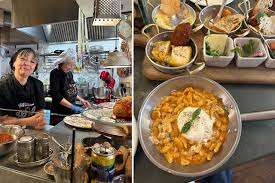Italy: Join a homegrown family feast in Basilicata region

Sarah Barrell
Rome: Deft and swift, she forms millimetre-thick sheets, slicing them into ribbons that she wraps around her narrow rolling pin to shape the screw-like ssëppondapòrtë (the word for ‘door hinge pin’ in local dialect) or cuts into the roughly square-shaped takkënuèddë. Next, the remaining dough — an egg-free mix of semolina flour and 00 pasta flour — is divided and rolled into thin sausages. She cuts these into one- and two-finger-width pieces and presses them into cavatelli and orecchiette, her digits moving in a blur of speed. Maria Coppola Colucci has been working in the kitchen at this pace for two hours and the septuagenarian grandmother shows no sign of flagging.
“We were in the garden first thing this morning digging up potatoes, too,” says her daughter, Miriam, laughing. There’s much to be done. This weekend, the world will arrive in Castelgrande, a clifftop village high in Basilicata’s mountainous hinterland. It’s mid-August, when residents gather for Borghi e Sapori, a three-day home-cooked food festival that takes over the town’s steep cobbled streets, swelling its barely four-figure population with diaspora from as far and wide as Venezuela, Australia and Canada.
But between then and now, we have to eat. And Maria has that in hand. The mingling aromas of yeasted dough proving in a bowl under the kitchen fireplace and lamb roasting in the oven hint at some of the dishes already in progress. The sharp scent of the province’s large, pungent basil leaves joins the mix, freshly washed on the draining board, still warm from the sunshine — along with the tomatoes and sweet onions for our lunch’s accompanying salad. They’ve all been plucked from the garden below the family’s first-floor apartment in the new hillside district that grew up around Castelgrande’s once earthquake-ravaged heart.
Like many rural villages in Italy’s south since the Second World War, Castelgrande’s story is one of steady emigration. Each new generation, born onto shaky ground — both economically and seismically in this fault-line-webbed Italian province — has been lured from subsistence farming to the more lucrative call of Rome, Milan and far beyond. But the town’s culinary heritage has strong roots, drawing emigrant families back each summer for a taste of their ancestral home. In the kitchen, alongside Maria, we have representatives from Milan (Miriam, who moved there some years ago seeking work as teacher), family friends Angela Federici and Izzy Coppola from Montreal, and me, the British wife of a second-generation Castelgrandese long settled in London.
The conversation amplifies over the spit and hiss of the stove where those freshly dug potatoes, now peeled and sliced, are frying in a pan of oil seasoned with red pepper flakes. In another pan, dried peperoni cruschi, long sweet red peppers, are also shallow frying, whole. And in yet another, a homemade tomato passata is cooking with finely diced onions, to which Maria adds local walnuts that Miriam has ground in a pestle and mortar, to make a distinctive regional sauce often served for festive occasions.
The chat volume rises, certain words spoken in old, and in some cases almost forgotten, dialect. “I remember ‘Cëtrulë’ was a favourite,” says Angela with a laugh. The local word for ‘cucumber’, more commonly used by Maria’s parents’ generation as a ribald insult, draws Maria’s husband Francesco out of his office. Certain things — rude words, family recipes — are well worth preserving. Angela is here with a Canadian cultural delegation, as president of the Associazione Maria SS. Di Costantinopoli di Castelgrande. “The association was founded in Montreal in 1988 by four young guys to represent the village in Canada,” she says. “They started with a festival for one of its saints, Maria of Constantinople, and it soon became more of a cultural thing — to keep Italians in Canada in touch with the food and language of their roots.” Now many Montreal Castelgrandese, Angela tells me, speak more dialect than people here.
As we chat, Maria tends to the potatoes, which are now ready, having been combined with slices of cured salsiccia sotto sugna sausage she warmed in the pan. “These pork sausages are handmade locally,” says Miriam. “Today, they mostly come vacuum-packed, but were traditionally preserved in jars of sugna — lard or ‘strutto’ in proper Italian.” They would then be kept in a cantina, she tells me, the cold larder found in all village houses.
A classic meal for farmers after an early morning’s work, this potato dish is more breakfast than lunch (although still traditionally accompanied by a tumbler of red wine). Today, it lands somewhere in between the two meals, with an egg — fresh from the family’s chickens — loosely stirred through at the end. We dig in, taking turns with our forks. Rich and salty, it’s a breakfast of champions, the potatoes browned with pork fat, the peppers and eggs adding a sweet-savoury finish.
We’re joined by Alberto Muro, a relation and former Castelgrande mayor. Tall with a statesman-like grey beard, Alberto is passionate about cultural preservation and revitalising the depopulated town. “We’ve worked with a university in India to learn how to cultivate saffron,” he tells me. “It turns out that we have ideal growing conditions.” The dry, well-drained soils here in Basilicata’s Potenza region look like fertile terrain for future industry. In the meantime, Alberto is reaping the rewards of his beehives. “It’s a millefiori,” he says proffering a jar of honey. “Made from bees that feed on mountain wildflowers.” I try some and it delivers a rolling floral menu from orangey citrus to subtle camomile.
A short, steep walk into the town centre reveals more regional produce at Basilicòre. The sleek, modern boutique contrasts with Castelgrande’s commercial life, which otherwise comprises just two rustic grocery stores and a small bakery. Its chic displays range from local saffron to honey, bags of pasta and peperoni cruschi. There are mountain beans and black chickpeas as well as unique varieties of legumes and lentils, all grown for centuries across Lucani — an ancient territory taking in Basilicata, parts of Calabria and Campania, cooked into smoky fireside stews in the kind of earthenware pots Maria has at her hearth. A wall of wines showcases bottles from the Vulture vineyards of inland Basilicata, famed for their black-red aglianico grape.
Like most buildings in Castelgrande, terraced along streets that coil tightly up to the Church of Santa Maria Assunta, Basilicòre has a cliff-edge back terrace opening onto a sheer-drop mountain panorama. The Apennines plummet and peak ever outwards towards the horizon, from deep valley pastures to theatrical tabletop plateaus. Muro, the closest town, a sizeable commercial centre, is a 15-minute drive away, along the supremely scenic highway recently carved discreetly through the mountains to Castelgrande’s south.
For now, though, the village bakery will suffice. Displayed next to the till, five kilo sacks of flour say much about the village’s home-baking self-sufficiency; however, we return to Maria with a huge pagnotta loaf of crusted durum wheat and semolina flour, typical of this grain-belt region of Italy’s south. Torn into chunks, it’s the perfect vehicle to scarpetta (literally ‘little shoe’, but in this context, ‘scoop’) the fatty juices of the lamb that’s now ready. Its marinade of parsley, sage, oregano and garlic — all from the garden — has filled the apartment with a meat-rich steam. “When it smells good, you know it’s ready,” says Maria, smiling. “I also added white wine; sometimes I use vinegar — you need the acidity to balance the fat.”
First, though, comes takkënuèddë, served with the walnut and tomato sauce, delicate yet earthy, light yet wholesome. It’s sprinkled with fried garlicky breadcrumbs rather than parmesan, the customary ‘peasant food’ flourish of Italy’s south. The lamb follows, heaped with roughly chopped potatoes that have roasted with the meat for the last hour. Knuckles, cutlets and neck yield with the touch of a fork, while the soft yellow potatoes are almost caramelised. The dish’s richness contrasts perfectly with the simple garden salad — red onions, romaine, basil and heirloom tomatoes, sharp with red wine vinegar and dark green olive oil — and the peperoni cruschi, which we bite into whole.
Maria, constantly dashing back and forth to the kitchen, drops spoons of her now-proved dough into hot oil to make scarpèddë. These flash-fried little doughnuts are then drizzled with Alberto’s honey and accompanied with espresso, made in a giant stove-top moka, as well as little icy shots of Maria’s limoncello liqueur, produced from the legendary lemons of the Amalfi Coast, about 60 miles to the west.
That we have capacity to eat again a few hours later is a wonder. But we do, grazing at makeshift stalls lining the streets raking down from Castelgrande’s church-crowned summit. There are plates sagging under the weight of the town’s signature cavatelli pasta, topped with a sunny tomato sauce; delicate, freshly minced meatballs combining veal, pork and beef; hefty panini, thick with homemade salumi; and fire-braised arrosticini skewers of lamb. But the standout, for me at least, is the caciocavallo — southern Italian bowling ball-like cheeses served impiccato, hung by their signature string over a grill, and melted raclette-like onto crusty bread topped with honey and truffle oil. It delivers a sweet-salty-umami hit of crunch and cheese-pull that induces reverent nodding from diners.
The sun sets, sending a halo of pink through the valley below, thick veils of evergreen forest and mountain pastures unfurling into the growing dark. Out there, the Podolica cows that provide the milk for the caciocavallo will be called in for the night to the modest masseria, country house farms that many local families own. The darkening sky blinks to life with a Milky Way display of such starry clarity it’s easy to see why scientists come from across the world to the observatory that stands like a stationary spaceship on a rocky outcrop above the farmland just outside town.
The party goes on late into the night, wheezy squeeze-box accordions playing old folk music lately revived by the town’s youngsters. But of course, Maria is up again at dawn, bringing in crops of tomatoes, peppers and courgettes as well as countless legumes and root vegetables that will go into ciambotta soup-stews that use up the summer’s glut — or are pickled in jars to see out the winter months. I join her and Francesco outside their garage, putting bucket-loads of tomatoes through a recalcitrant motorised press. And there is, of course, time for one more meal: jewel-bright tomato passata, just off the press and warmed into a quick sauce flavoured with nothing more than a couple of basil leaves and some olive oil, served over spaghetti. “Tutto e grazie al dio,” Maria said the day before, noting the blessings of her abundant garden. That deceptively simple red sauce certainly seems touched by the celestial, singing of the sunshine, of the earth and of a family’s labour of love.





